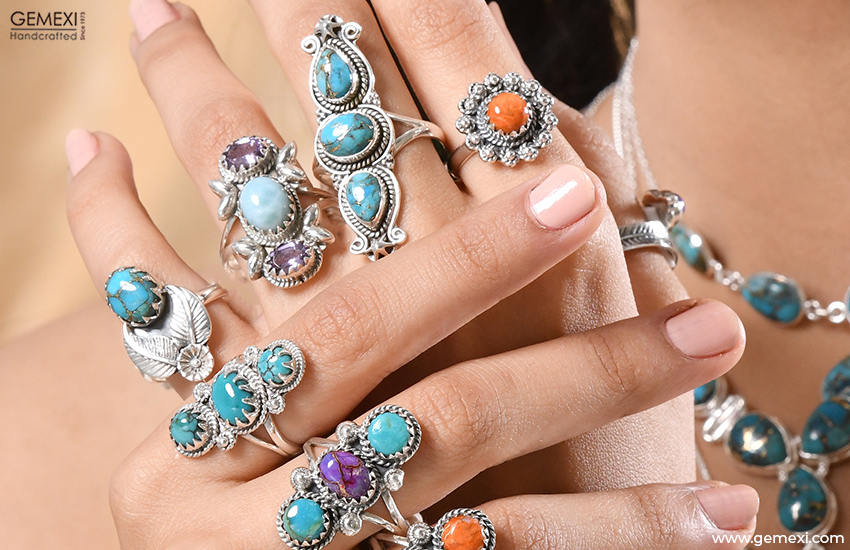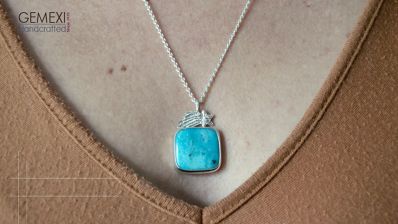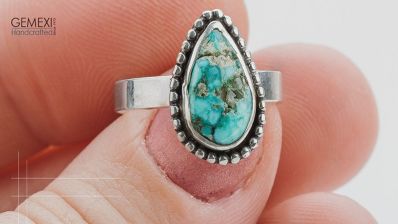An Expedition Through Southwest Turquoise: Exploring Ten Types and Their Makers
By Gemexi Team | Turquoise- Updated On Jun 27, 2023

Delving into the world of Southwest turquoise is like unearthing hidden treasures, rich in colors, textures, and histories. This blog will walk you through ten mesmerizing types of turquoise, which are unique to the Southwest, shedding light on their origins and the virtuosos who transform these raw stones into timeless pieces of jewelry.
Turquoise, a phosphate mineral known for its captivating range of blue and green hues, holds a special place in the Southwestern Native American culture. As it continues to rise in popularity, jewelry makers are striving to preserve the heritage, art, and spiritual significance that every turquoise stone carries.
Turquoise, a phosphate mineral known for its captivating range of blue and green hues, holds a special place in the Southwestern Native American culture. As it continues to rise in popularity, jewelry makers are striving to preserve the heritage, art, and spiritual significance that every turquoise stone carries.
- Sleeping Beauty Turquoise: Found in the Sleeping Beauty Mine in Globe, Arizona, this turquoise is renowned for its solid, light blue color with little to no matrix. Known for its purity and consistency, Sleeping Beauty Turquoise is a favorite of artist Aaron Toadlena, whose handcrafted pieces exhibit a perfect balance of tradition and sophistication.
- Kingman Turquoise: Sourced from the oldest active mine in Arizona - the Kingman Mine, this type of turquoise is celebrated for its variety of colors from light blue to high blue, and its distinct veining or matrix. Jewelry artist Edison Sandy Smith uses Kingman turquoise to create striking necklaces, bracelets, and rings with intricate silverwork.
- Bisbee Turquoise: The Lavender Pit Mine in Bisbee, Arizona is the source of this rare and highly coveted turquoise. Bisbee turquoise is cherished for its unique deep blue color and chocolate brown matrix. Sam Gray, a renowned Navajo silversmith, has worked wonders with Bisbee turquoise, crafting exquisite belt buckles and squash blossom necklaces.
- Morenci Turquoise: Mined in southeastern Arizona, Morenci turquoise stands out with its bright blue hues and an iron pyrite matrix that sometimes gives a silver sparkle. James Saunders, a master in Hopi overlay technique, frequently incorporates Morenci turquoise into his works, producing pieces that mirror the rich landscapes of the Southwest.
- Number 8 Turquoise: Named after the Number 8 mine in Nevada, this turquoise is prized for its black, golden, and brown spiderweb matrix set against a unique green-blue backdrop. Award-winning silversmith Darryl Dean Begay often uses Number 8 turquoise in his art, bringing his vision to life with exceptional stone and silver work.
- Royston Turquoise: Known for its beautiful color ranges from deep green to rich, light blues set in a heavy brown matrix. Royston Turquoise is mined in the Royston mining district near Tonopah, Nevada. Vernon Haskie, a world-renowned Navajo artist, transforms this diverse stone into masterpieces of wearable art.
- Carico Lake Turquoise: Carico Lake turquoise is known for its blue-green colors and its remarkable lime-green hues. This stone, mined in a dried-up lake bed in Lander County, Nevada, has been expertly used by the acclaimed artist Orville Tsinnie in his designs.
- Cripple Creek Turquoise: This variety originates from the Cripple Creek mine in Colorado. With colors ranging from light green to a very light blue, its appeal lies in the exceptional matrix patterns. Noted artist Vernon Begaye frequently uses Cripple Creek turquoise to craft unique, contemporary pieces.
- Pilot Mountain Turquoise: Sourced from the Pilot Mountain mine in Nevada, this turquoise displays a wide range of colors from blue to green coupled with a distinctive dark matrix. Master jeweler Tommy Jackson beautifully incorporates Pilot Mountain turquoise into his traditional Navajo designs.
- Blue Gem Turquoise: Known as one of the classic American turquoises, Blue Gem, hailing from Nevada, displays a diverse range of blues and greens. Legendary jeweler Frank Patania Sr. often used Blue Gem in his creations, drawing inspiration from traditional Native American and Mexican design elements.
Native American and Southwestern jewelry, especially turquoise, is increasingly gaining recognition and popularity around the world. These beautiful pieces are not merely accessories; they carry stories, traditions, and the spirit of an ancient culture. The vibrant turquoise stones, each uniquely born of the earth, combined with the artisan's skill and imagination, result in nothing less than a wearable art form. The ten types of turquoise stones explored here are the building blocks for these artists, allowing them to keep their culture alive and thriving through their stunning jewelry creations.

In the current era of fast fashion and mass production, the art of handcrafted Native American and Southwestern jewelry using these exquisite turquoise stones stands out even more. The growing popularity is a testament to the deep appreciation for the rich history, unparalleled craftsmanship, and the pure beauty these pieces of jewelry embody. Every turquoise stone has a story to tell, and through the hands of these remarkable artists, those stories continue to be told, admired, and cherished.

In the current era of fast fashion and mass production, the art of handcrafted Native American and Southwestern jewelry using these exquisite turquoise stones stands out even more. The growing popularity is a testament to the deep appreciation for the rich history, unparalleled craftsmanship, and the pure beauty these pieces of jewelry embody. Every turquoise stone has a story to tell, and through the hands of these remarkable artists, those stories continue to be told, admired, and cherished.
- Tags:
- Turquoise
- Bisbee Turquoise
- Kingman Turquoise
- Royston Turquoise
- Morenci Turquoise
- Cripple Creek Turquoise










0 Comments
Write Comments